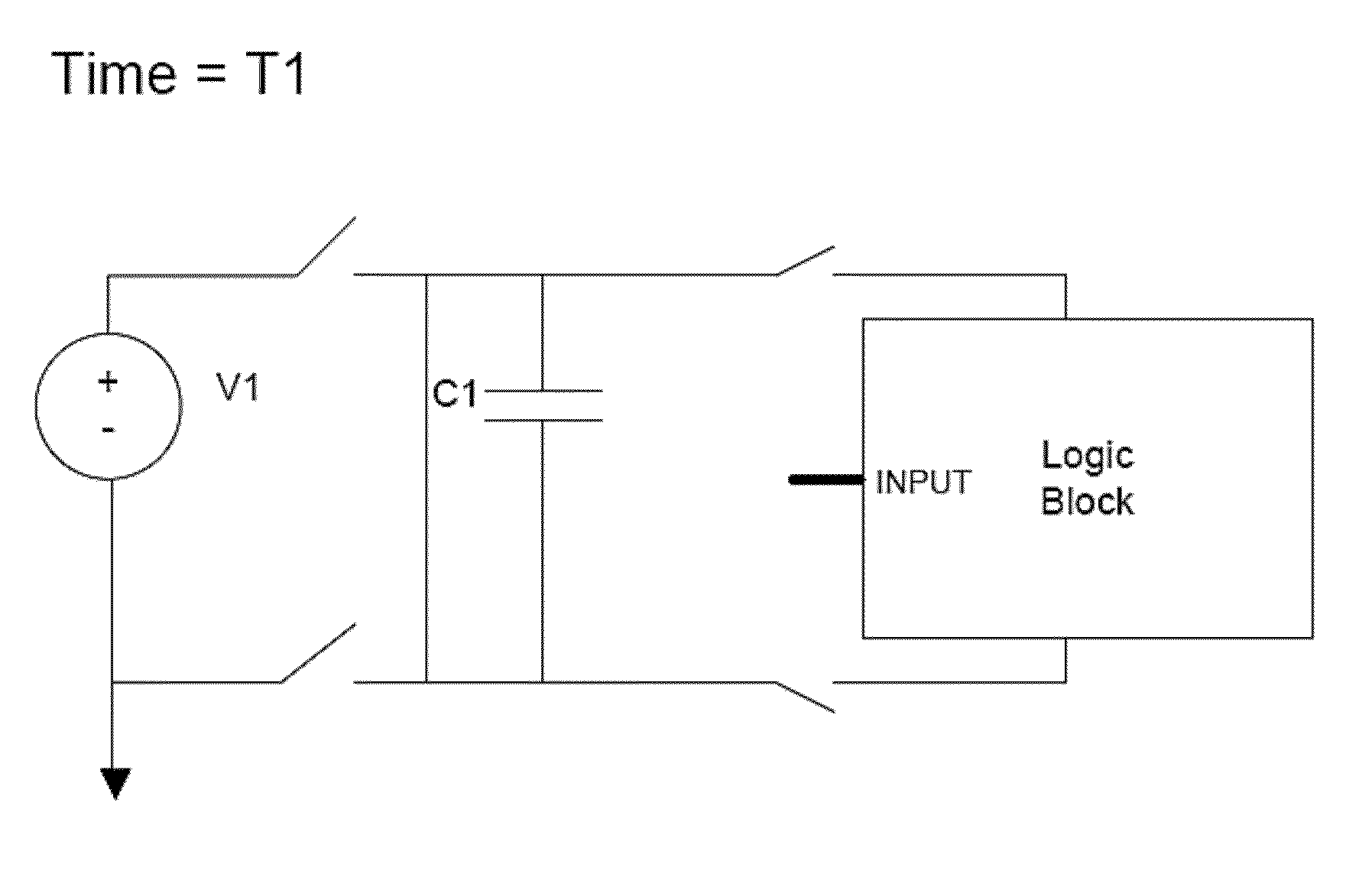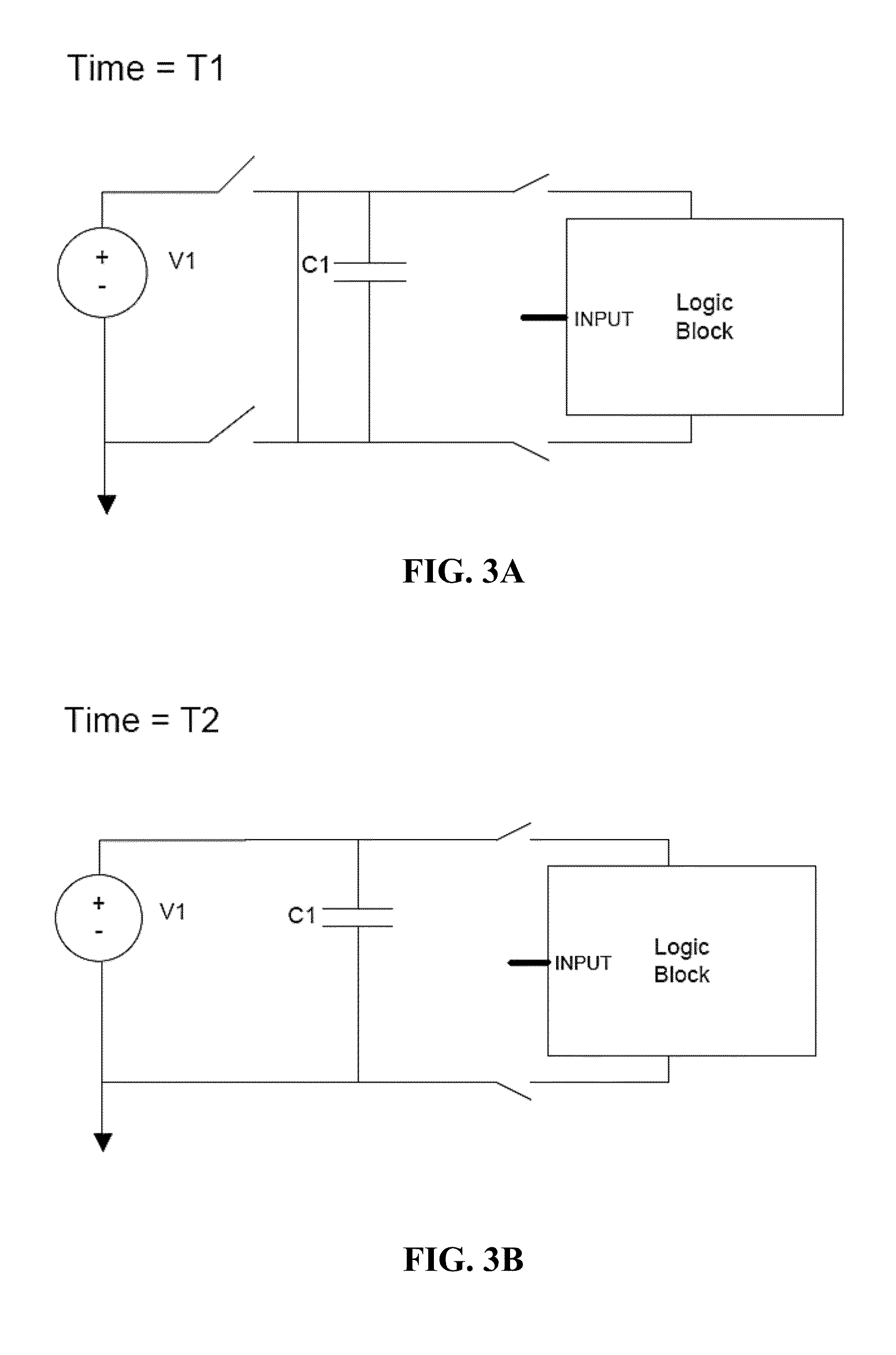Charge distribution control for secure systems
- Summary
- Abstract
- Description
- Claims
- Application Information
AI Technical Summary
Benefits of technology
Problems solved by technology
Method used
Image
Examples
example 1
[0119]FIG. 4 is a schematic representation of an implementation of a CCDL circuit according to an embodiment of the invention. Referring to FIG. 4, MOSFETs M1, M2, M11, M12, and M13 are used to implement the switches seen in FIGS. 1 and 3A-3D. MOSFET M5 is used to implement the capacitor C1. MOSFETs M3, M4, M6, M7, M8, and M10 implement a static logic “AND gate.”
[0120]In a first phase, MOSFETs M1, M2, M11, and M12 are disabled (turned off) to decouple the logic block and the power supply from capacitor M5. Immediately following, M13 is enabled (turned on) to couple the gate of M5 to the source and drain terminals of M5, thereby allowing the M5 to discharge.
[0121]In a second phase, M2, M11, and M13 are disabled to decouple M5 from the logic block. MOSFETs M1 and M12 are then enabled to couple M5 to power supply lines VDD and VSS, thereby allowing M5 to charge.
[0122]In a third phase, MOSFETs M1, M12, and M13 are disabled to disconnect M5 from supply lines VDD and VSS. Immediately afte...
example 2
[0125]FIG. 5 shows a clocking scheme for a CCDL logic cell. The signal SL_CLK represents an input to a CCDL cell that would induce a logic transition. The transitioning of signals CLK1 and CLK1B disconnects the logic block from the supply capacitor and the power supply. The limiting factor in determining the max operation speed of a CCDL cell or a CCDL based circuit block is the necessity for all logic transitions within the CCDL block to be complete before CLK1 and CLK1B signals disconnect the logic block within the CCDL cells from the supply capacitor powering the logic blocks.
[0126]Once the CLK1 and CLK1B signals have decoupled the logic block from the supply capacitor, CLK3 can transition and discharge the supply capacitor. Finally, CLK2 and CLK2B signals transition to allow the supply capacitor to be charged by the power supply. It should be noted that, the transition edges of each of the CLK signals do not overlap. The non-overlapping clocks inhibit, for example, the power sup...
example 3
[0127]A CCDL cell as shown in FIG. 6 was tested. The discharge switch for the cell in this example utilizes a transmission gate of NMOS transistor M13 and PMOS transistor M14. Testing of the CCDL cells within a larger circuit demonstrated a small but significant level of current, i.e., tens of micro amps, flowing through the substrate of the circuit and into the power supply during switching events of the CCDL logic. Although small, some level of information may have been extractable from these currents about the logical operations of the CCDL circuit. Two approaches were implemented to reduce this. First, the body tie of each device in the CCDL logic cell (circled on the right) was tied to the internal supply rails of the CCDL cell, i.e., CP_RL and CP_GND. This attempts to flow as much of the substrate current generated during logic operations as possible into, and / or out of, the power capacitor.
[0128]The second approach used to reduce current on power and ground lines is shown in ...
PUM
 Login to View More
Login to View More Abstract
Description
Claims
Application Information
 Login to View More
Login to View More - R&D
- Intellectual Property
- Life Sciences
- Materials
- Tech Scout
- Unparalleled Data Quality
- Higher Quality Content
- 60% Fewer Hallucinations
Browse by: Latest US Patents, China's latest patents, Technical Efficacy Thesaurus, Application Domain, Technology Topic, Popular Technical Reports.
© 2025 PatSnap. All rights reserved.Legal|Privacy policy|Modern Slavery Act Transparency Statement|Sitemap|About US| Contact US: help@patsnap.com



